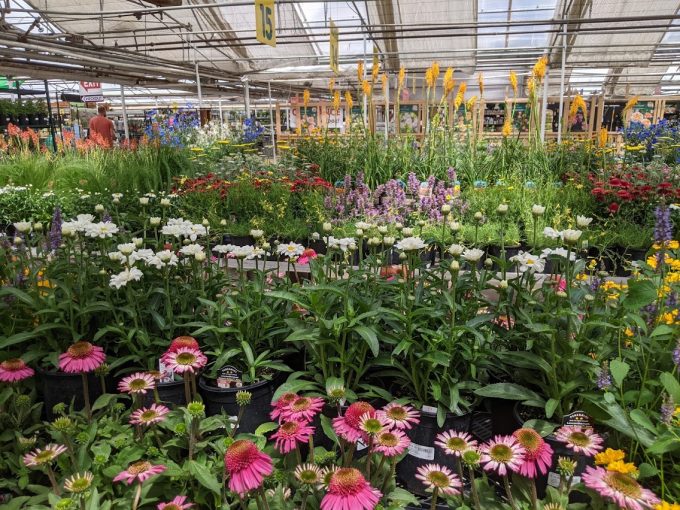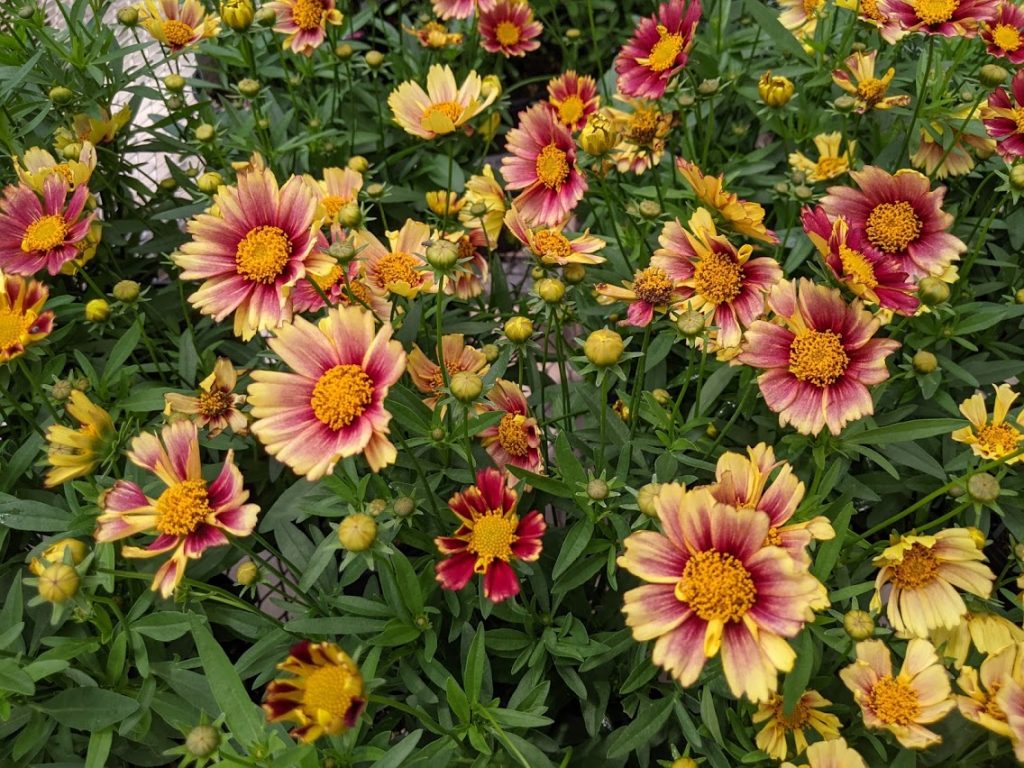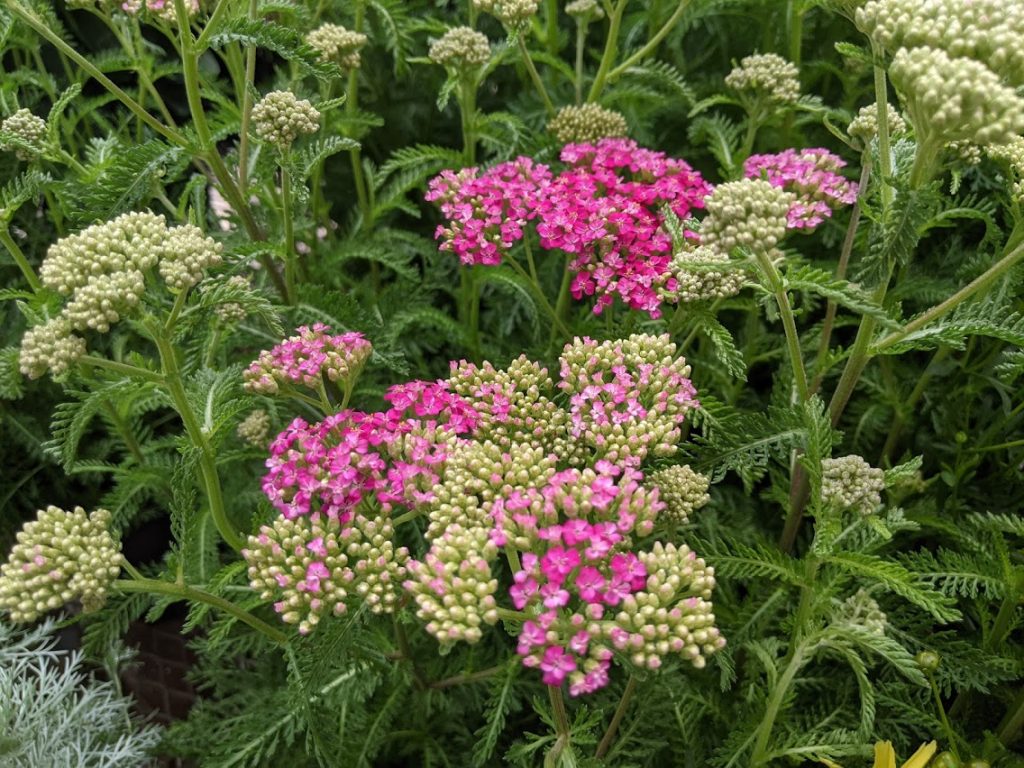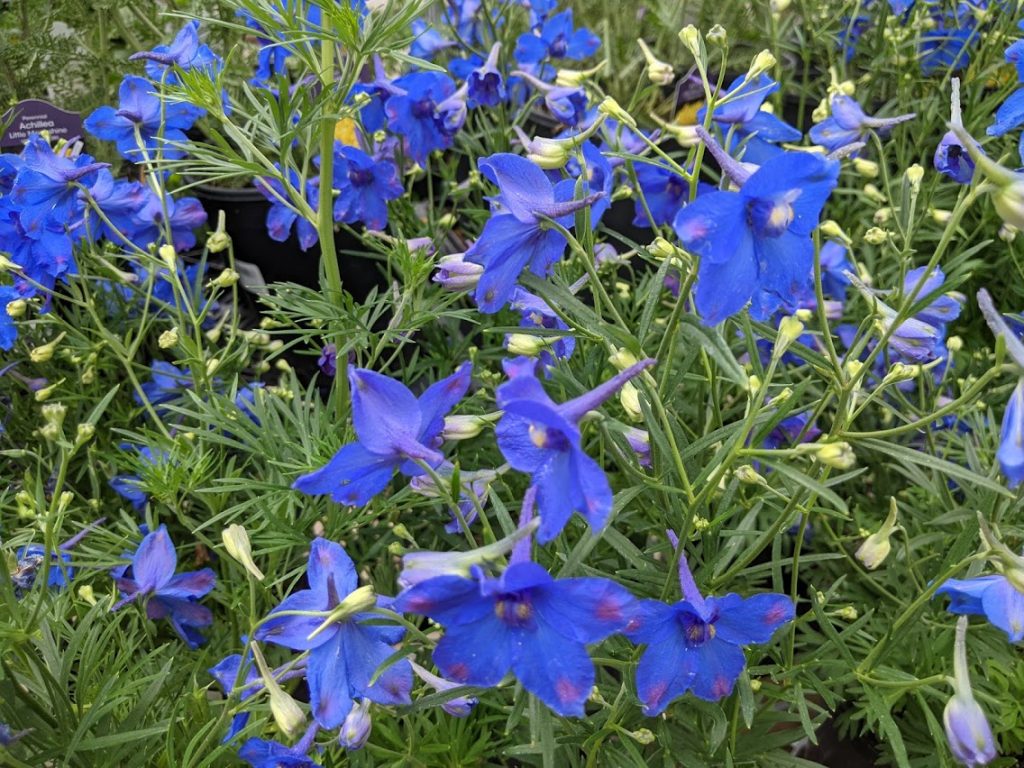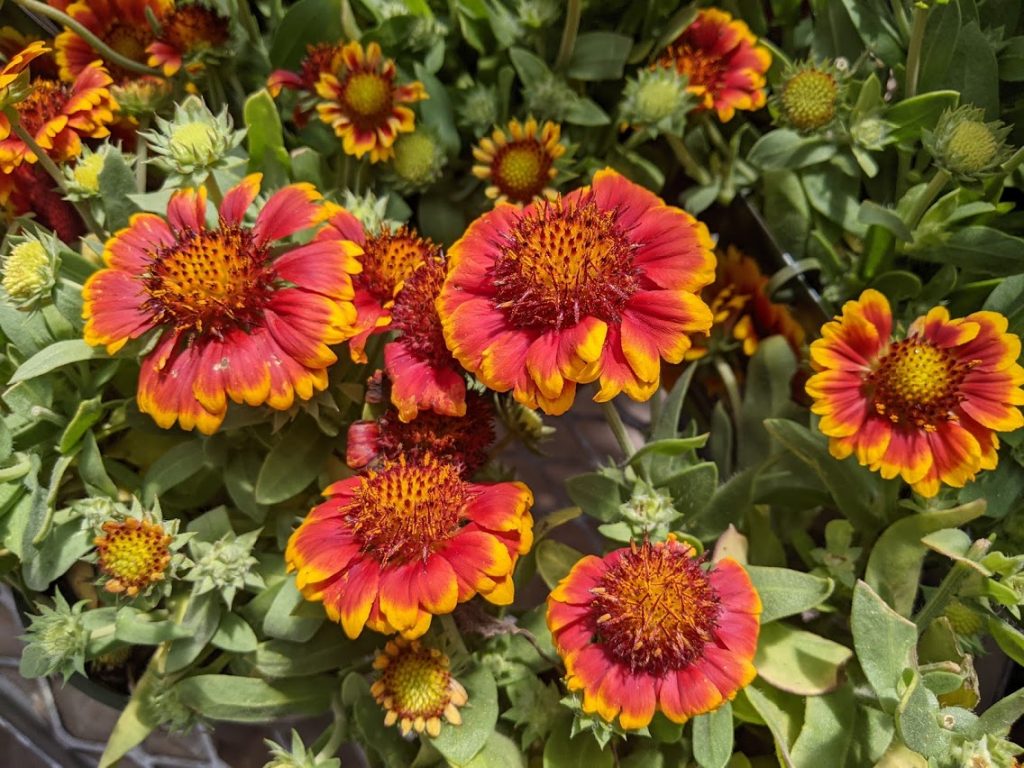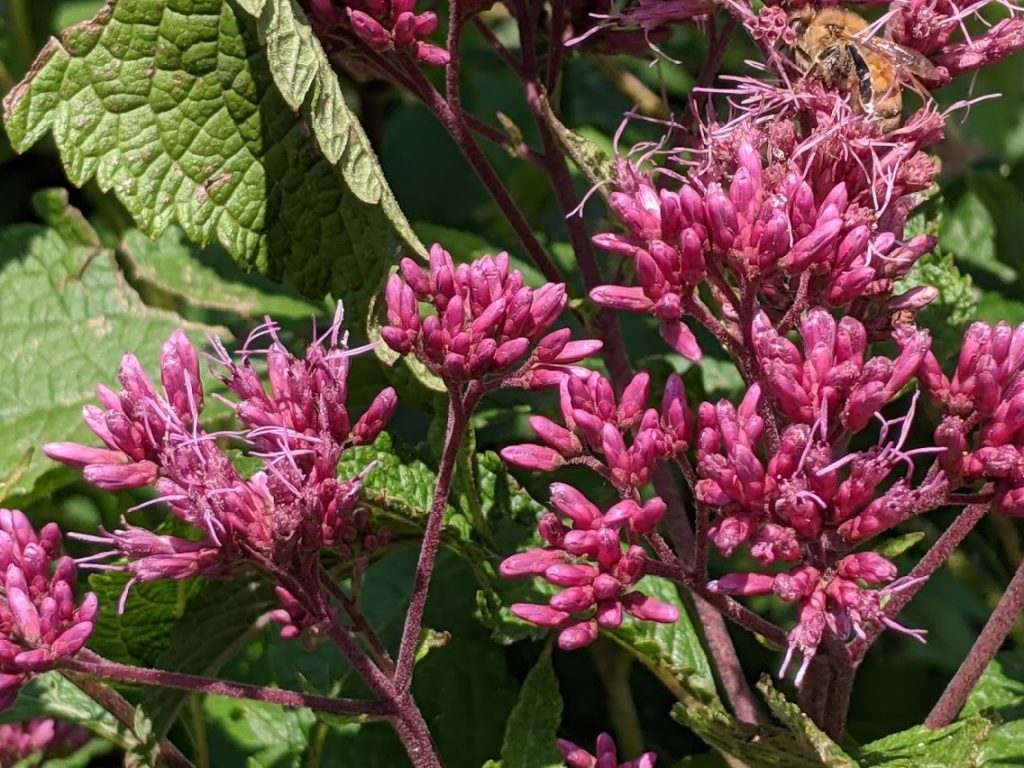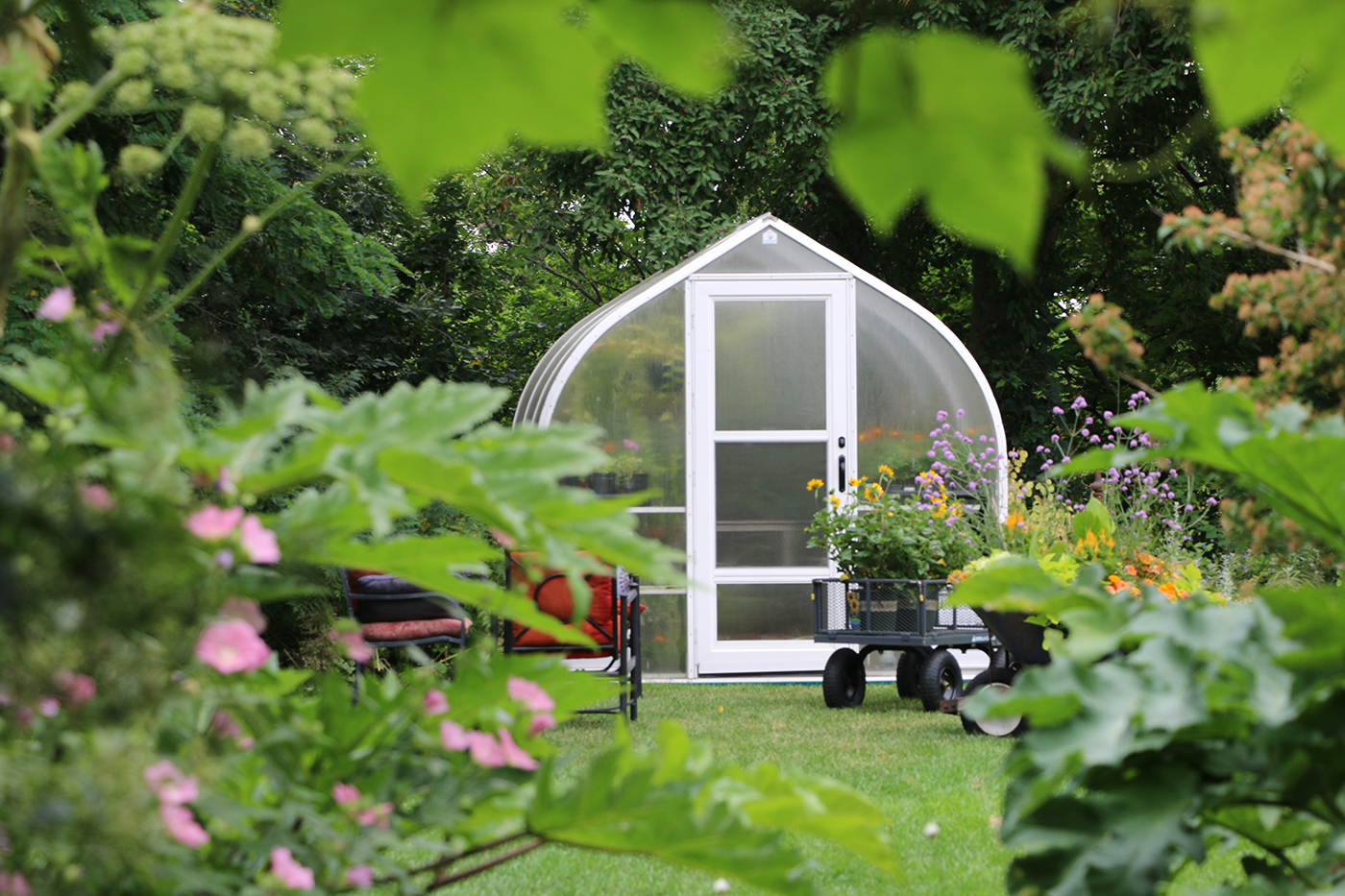Question: Where can you find thousands of vigorous right-off-the-truck perennials, blooming or about to bloom?
Answer: Tagawa Gardens, of course!
With so many plants, where in the world should I start? How about with one of the plants that I fell in love with the minute I saw it!“
“Sunset Burst” coreopsis
Different varieties of yellow and yellow/red coreopsis have always found a home in my garden. But there’s a new kid on the block you might fall in love with, too!
Sunset Burst burst’s soft yellow and peach had me at “hello!” Happy, frilly flowers, and lots of ’em! Sunset Burst needs full sun, grows up to 20″ tall and 18″ wide. It’s heat-tolerant and prefers deep but infrequent watering once it’s “established,” meaning after two seasons in the ground. It blooms all summer long. Give it a light shearing after the first flush of flowers, then just wait for round two!
Tagawa’s has plenty of Sunset Burst coreopsis, minus the two I grabbed as I was taking pictures. But as with all these perennials, it’s first-come, first-served. I’m guessing this one may go quickly!
“Cherry Sparks” penstemon
You want something red? Well, here ya are!
Tagawa always carries a lot of beautiful penstemon as the gardening season begins, but this one is a real eye-catcher!
Cherry Sparks will be calling to the hummingbirds the minute its tubular flowers open. It needs full sun and deep but less frequent watering once established. It grows up to 18″ tall and wide and blooms from late spring to fall. Deadheading, removing the blossoms as they begin to fail, will definitely help to keep the flowers coming.
“Siren Song Layla” yarrow
Quite the name, I know, but this pretty pinkish-purple yarrow sang to me, and I listened!
Siren Song Layla is a nice alternative to the tried-and-true densely yellow “Moonshine” varieties we’re familiar with. (We have those in stock, too, if that’s your preference.)
Native bees find the clusters of tiny flowers on yarrow especially appealing. Siren Song blooms late spring into summer. As the flowers fade, they can be clipped back and used in dried arrangements. A smaller second flush of flowers will emerge.
Siren Song needs full sun and occasional deep watering once established. It grows up to 22″ tall and 24″ wide.
“Mango Popsicle” kniphofia
Sounds good enough to eat, doesn’t it? The red varieties of kniphofia (a.k.a. “red hot poker”) can be striking, especially when grown in clumps, but this soft orange version is also a keeper!
Mango Popsicle is a dwarf variety, growing up to 30″ tall, once the flowers have opened, and 18″ wide. It requires full sun and will do best in a somewhat sheltered area in our Front Range gardens, a site with just a bit of winter protection. It’s also a “fire-wise” plant, making it a good option to grow in gardens near homes where wildfires may be a factor. Kniphofia is deer and rabbit-resistant, too. (Side note: nothing is critter-proof. If the deer and rabbits are hungry enough, fencing is pretty much the only answer.)
Mango Popsicle starts sending up flower stalks in late spring and should continue to bloom into the fall, as long as the fading flower stalks are removed consistently.
“Blue Butterfly” delphinium
Tagawa’s carries this lovely plant frequently, but it’s so beautiful, it deserves some time in the spotlight now, too.
Blue Butterfly delphinium is about as blue as blue can be. Its frilly foliage is a big bonus, too. Blue Butterfly is happy with full sun but performs best when it’s not grown in lots of heat. This delicate-looking marine blue standout grows up to 14″ tall and 12″ wide. It prefers soil that is moderately moist, but never soggy.
Blue Butterfly isn’t an especially long-lived perennial, but definitely puts on a show when it’s in flower in June and July. Cutting it back hard can lead to another smaller flush of flowers later in the season.
“Barbican Yellow Red Ring” blanket flower
The name pretty much says it all. If it’s bold colors you want, this plant is for you!
Blanket flowers are known as workhorses in the garden. Barbican Yellow Red Ring is described as a “carefree plant with nearly non-stop blooms from late spring through summer.”
It needs full sun and will grow up to 18″ tall and wide with a roundish habit. Water it well, then let the top of the soil dry slightly before watering again.
Blanket flowers are good for attracting butterflies and bees, so they make an excellent addition to pollinator gardens.
“Mandarin” honeysuckle
I have to admit: I don’t have a lot of bright orange in my garden. Just not my thing. But with the same breath, I’m saying I would gladly plant Mandarin honeysuckle. Soft orange and dense orange just aren’t the same thing!
Flowers definitely don’t have to be red to draw hummingbirds. The shape of the flowers brings them in, too, and the narrow tubular flowers of honeysuckles are “game on” for these lovely little birds. What else can reach down deep for that sweet nectar in a honeysuckle blossom?
Mandarin is a vigorous twisting, quick-growing vine that will reach up to 20′ high (or 20′ long, as along a fence once it’s reached the top of a trellis), and as wide as it’s trained. It does best in full sun. It should be watered well when the top two inches of soil is dry.
Mandarin honeysuckle will bloom from late spring through the summer. It is deciduous in our climate, so it will lose its leaves in the fall.
“Red Dwarf” joe-pye weed
If you love gardening for the pollinators, but don’t have room for this plant’s seven-foot-tall big brother, Red Dwarf joe-pye weed may be just what you need.
Red Dwarf grows up to three feet tall and wide. It gets its name from the rich red stems that hold up the clusters of pink to wine-colored flowers.
All varieties of joe-pye weed are attractive to butterflies, but as I was taking this picture, the gentle native bees were out in full force. I loved it!
Red Dwarf can grow in full sun, but in some settings, a bit of afternoon shade may help keep the foliage looking its best. It needs rich, lightly but consistently moist soil, never soggy. It blooms mid-summer into fall.
The nectar-rich flowers appear on new growth. Red Dwarf can be left unpruned over the winter to add interest to the landscape, but the dead stems should be cut back in March or April to clear the way for the next season’s blossoms.
The challenge of Tagawa’s eye-catching selection of perennials? What to choose!
Our eye-popping display of perennials might stop you in your tracks for a moment, but we’re pretty sure you’ll get over it. But don’t let the forecast scare you away! We have some hot weather still to come, but with proper care, this is a great time to plant!
Hardening off is critical! Don’t take these lovely perennials home and put them in the ground right away. Set them in a shady protected place outdoors for a couple of days, then gradually introduce them to the sunny, low-humidity world of our Colorado gardens. Make sure to keep them well watered while they’re being acclimated to life outside of our garden center, but never leave them in standing water.
Tagawa’s Garden Coaches have a free detailed handout on how to care for newly-purchased perennials. Make sure to ask for it while you’re shopping.
The plants I’ve featured here are the tiniest snapshot of what Tagawa Gardens has to offer.
We’d love to see you and help you discover many new perennials. You won’t be disappointed!
